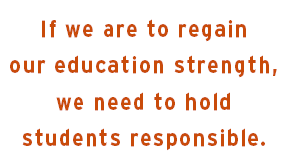 The American high school no longer works, Bill Gates tells us, not for the best or the brightest, nor for those at risk of falling off the education ladder.
The American high school no longer works, Bill Gates tells us, not for the best or the brightest, nor for those at risk of falling off the education ladder.
Gates is right. Take the latest results from the National Assessment of Educational Progress (NAEP), the nation’s report card, which just updated to 2004 the “progress” we haven’t made since the early 1970s. Even among the “talented tenth,” those in the top 10 percent of test-takers, reading scores have dropped 4 points since 1971, and math scores have not budged since they were first measured in 1978. In August the College Board released results from the latest SAT exams, announcing that the scores were “an all-time high.” Overlooked by most of the press was the fact that the increases were caused by private-school improvements; SAT scores for public school students were stagnant.
At the other end of the scale, dropout rates have actually increased since 1990, rising to 30 percent of all 17-year-olds. Among African Americans the dropout rate is somewhere between 50 and 60 percent, a sad fact that is one of the best-kept secrets in American education. So few people know how big these dropout numbers are that, in a recent book, Michael Dyson scolds Bill Cosby for (accurately) lamenting the fact that only half of African Americans graduate from high school (see p. 78). Dyson “corrected” him, saying the dropout rate is only 17 percent, an inaccuracy that earned Dyson warm praise from a New York Times book reviewer.
The Times error only shows how successful the public education cartel has been in deceiving the public. To hide the actual dropout rate, most school districts report as dropouts those who entered the year as seniors but did not remain in school until the end of that year. All the dropouts over the preceding three years, and all the summers in between, when most dropping out actually occurs, are statistically ignored.
The U.S. Department of Education has long been complicit in fostering the misperception. To his credit, Russ Whitehurst, head of the department’s Institute of Education Sciences, is now actively working to remedy the situation. So are the nation’s governors, recently embarked on a Herculean effort to develop a multistate definition of high-school completion.
Getting the facts right will be a start. And President Bush is to be congratulated on identifying the American high school as the place where school reform must now focus. But, as Chester Finn notes (see forum, p. 27), the administration’s strategy is going nowhere fast.
Several essays in this issue of Education Next show that we have based our high-school policies on two contradictory assumptions: 1) adolescents are experienced and can choose their own curriculum from the shopping mall of choices available; 2) adolescents should not be held responsible for their performance. Thus testing expectations should be minimalist and graduation requirements should be readily achievable, provided students comply with compulsory attendance laws. Just how this notion got started is well described in Jeff Mirel’s history of the American high school (forum, p. 14). And James Coleman’s classic essay (features, p. 40) reminds us that not much will change until the organization of schools fosters learning communities, not anti-learning ones.
No wonder the United States is desperately searching for ways to import talent, while excluding terrorists, from abroad. If we are to regain our education strength in a world where other nations are passing us by, we need to hold students responsible for more than just selecting the courses they want to take. To graduate from high school, students should be expected to pass, at as high a level as they can, a challenging, substantive examination in a variety of subjects that allows them to demonstrate, to colleges and to employers, just how accomplished they are. As Andrew Mollison shows (features, p. 34), the Advanced Placement test is a good beginning, but until more than 10 percent of all public school students take that test, it is not going to have broad impact.
Finally, as Jay Greene argues (forum, p. 23), high-school students, more mobile than their younger siblings, could challenge themselves if they were given a range of schools from which to choose, and those schools could also choose them, as happens at the college level. When both young people and high schools are given the opportunity to choose, each will begin to hold the other accountable.
— Paul E. Peterson


